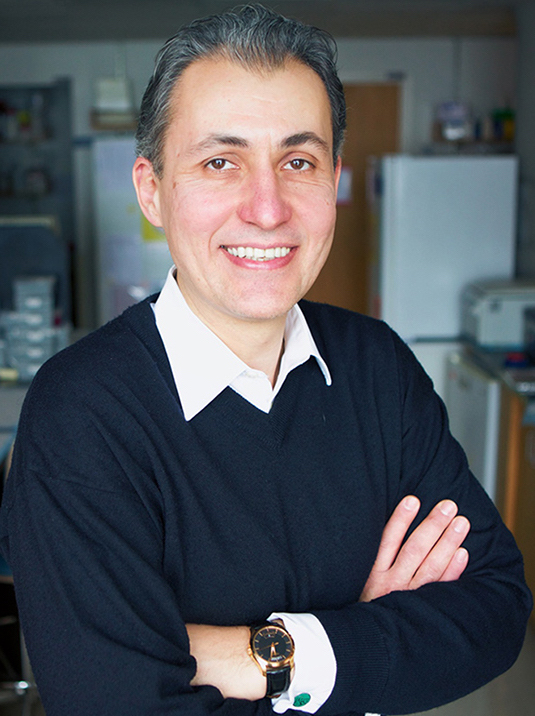Peer Reviewed Cancer
A Promising Nanotech Approach to Enhance Immunotherapy in Liver Cancer




Posted October 21, 2022
Jinjun Shi, Ph.D., Brigham and Women's Hospital, Harvard Medical School
Dan G. Duda, DMD, Ph.D., Massachusetts General Hospital

(Photo provided)

Dan G. Duda, DMD, Ph.D.
(Photo provided)
With an estimated 906,000 new cases annually, and 830,000 fatalities, liver cancer ranks as the third leading cause of death from cancer worldwide.1 Hepatocellular carcinoma (HCC) accounts for 75%-85% of all cases of liver cancer. With the advent of immunotherapy (immune checkpoint blockade [ICB]), game-changing treatments show promise for various malignancies, including HCC. Unfortunately, only a small subset of patients responds favorably, and ICBs are ineffective for most liver cancer patients. The low response rate is attributed, in part, to the immunosuppressive tumor microenvironment (TME) of the liver cancer. As such, researchers seek new TME-modulating therapeutics to be used in conjunction with ICB to boost the body's anti-tumor response and enhance patient outcomes. A tumor suppressor protein, p53, presents an avenue of hope for liver cancer patients.
Considered the guardian of the genome, the p53 gene is often mutated or lost in many cancers, including HCC. P53 acts as a tumor suppressor and protects the genetic integrity of cells by preventing the proliferation of aberrant cells via the regulation of genes involved in several biological processes. In addition to its role as a tumor suppressor, mounting evidence indicates that p53 regulates immune responses in the tumors, with p53 dysfunction being linked to impaired immune clearance and cancer progression.2 Studies show that p53 enhances anti-tumor immunity by regulating the transcription of key chemokines and cytokines (proteins that control growth, differentiation, and functional activities important in immune response), thereby facilitating the recruitment of cancer-fighting immune cells to the tumor site. While previous studies revealed the role of p53 in anti-tumor immunity, therapeutic options to effectively address p53 dysfunction and its role in immune modulation and immunotherapy resistance in HCC remains elusive. With a Fiscal Year 2018 Peer Reviewed Cancer Research Program Idea Award with Special Focus, Drs. Jinjun Shi (Brigham and Women's Hospital) and Dan G. Duda (Massachusetts General Hospital) jointly aimed to investigate the effects of p53 restoration on the TME in liver cancer, including in the context of standard anti-PD-1 immunotherapy.
The team synthesized self-assembling lipid-polymer hybrid nanoparticles (NPs) with a targeting sequence, enabling specific delivery of the encapsulated p53 mRNA to the liver tumors. Subsequent laboratory experiments confirmed the p53 mRNA NPs restored p53 expression in p53-deficient mouse HCC cells, coinciding with reduced cell growth and viability over time compared to treatment with control NPs. Using an immunocompetent orthotopic mouse model of p53-deficient HCC, the team demonstrated that p53 restoration augmented the efficacy of anti-PD-1 therapy. While single therapy with anti-PD-1 antibody alone modestly reduced tumor growth, co-administering anti-PD-1 antibodies with the p53 mRNA NPs significantly delayed tumor growth. Moreover, combination treatment was shown to significantly prolong survival, with animals receiving anti-PD-1 and p53 mRNA NP treatment reaching a median overall survival of 43.5 days, which was almost double that of the control group. Furthermore, combination therapy was the only method that reduced the incidence of hemorrhagic ascites and pulmonary effusion, both potentially lethal conditions commonly associated with liver cancer.3
The benefit of the combination therapy was mediated by a global reprogramming of the TME; this was marked by increased infiltration of immune cells associated with a favorable anti-tumor response. These results demonstrate that p53 mRNA NPs can enhance the anti-tumorigenic effects of anti-PD-1 therapy and could potentially serve as a novel therapeutic strategy for treating p53-deficient HCCs. The collaborative team is currently exploring the use of p53 mRNA NPs with other ICBs and with anti-angiogenic therapies, as well as a treatment strategy for p53-proficient HCC. They are also testing whether p53 mRNA NPs could have broader applicability beyond the treatment of HCC, for other p53-deficient cancers.
References:
1Sung H, Ferlay J, Siegel RL, et al. 2021. Global cancer statistics 2020: GLOBOCAN estimates of incidence and mortality worldwide for 36 cancers in 185 countries. e.May; 71(3):209-249. doi: 10.3322/caac.21660. Epub 2021 Feb 4. PMID: 33538338.
2Guo G, Yu M, Xiao W, et al. 2017. Local activation of p53 in the tumor microenvironment overcomes immune suppression and enhances antitumor immunity. Cancer Res. May 1;77(9):2292-2305. doi: 10.1158/0008-5472.CAN-16-2832. Epub 2017 Mar 9. PMID: 28280037; PMCID: PMC5465961.
3Xiao Y, Chen J, Zhou H, et al. 2022. Combining p53 mRNA nanotherapy with immune checkpoint blockade reprograms the immune microenvironment for effective cancer therapy. Nat Commun. Feb 9;13(1):758. doi: 10.1038/s41467-022-28279-8. PMID: 35140208; PMCID: PMC8828745.
Last updated Friday, December 13, 2024














